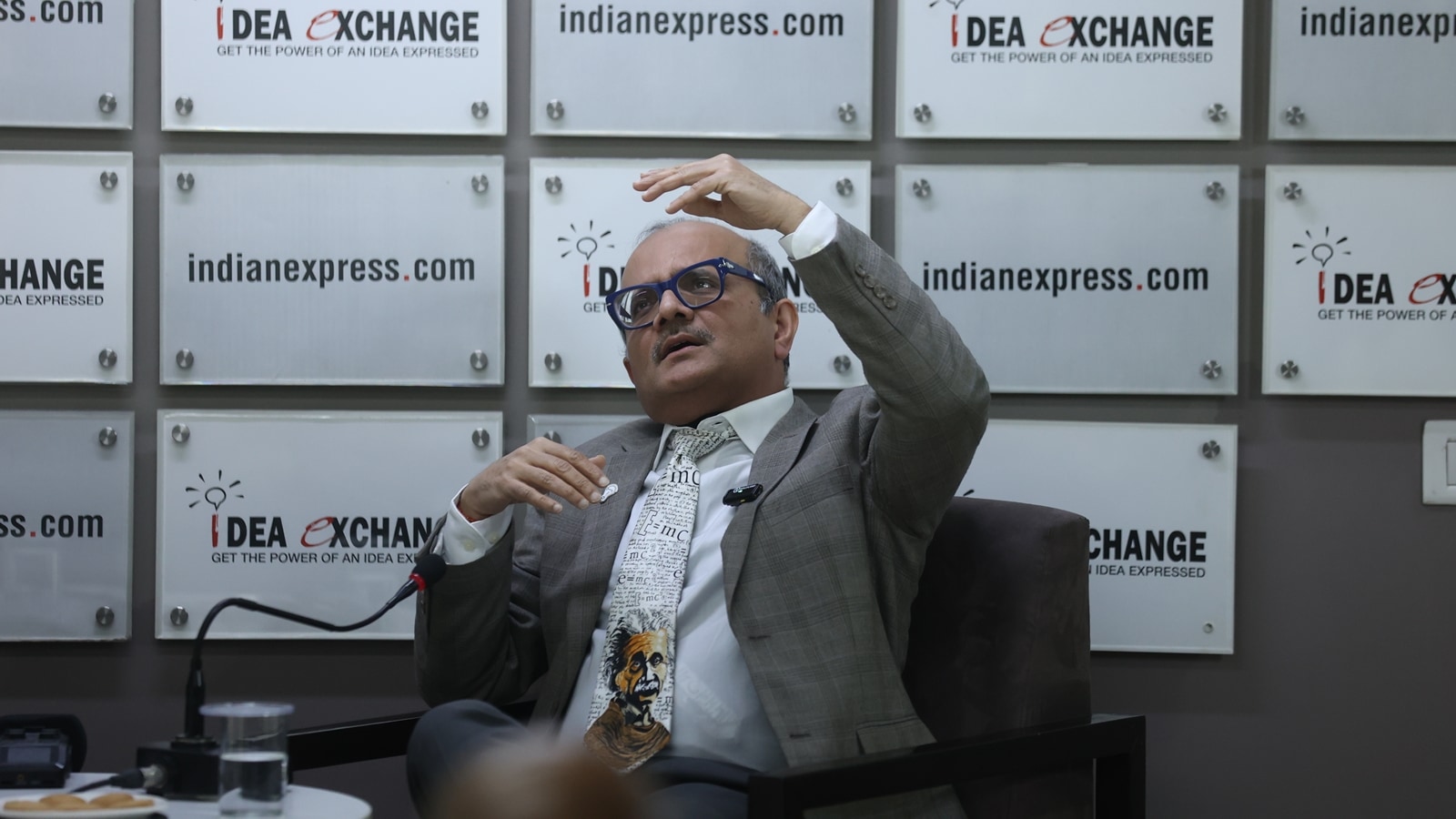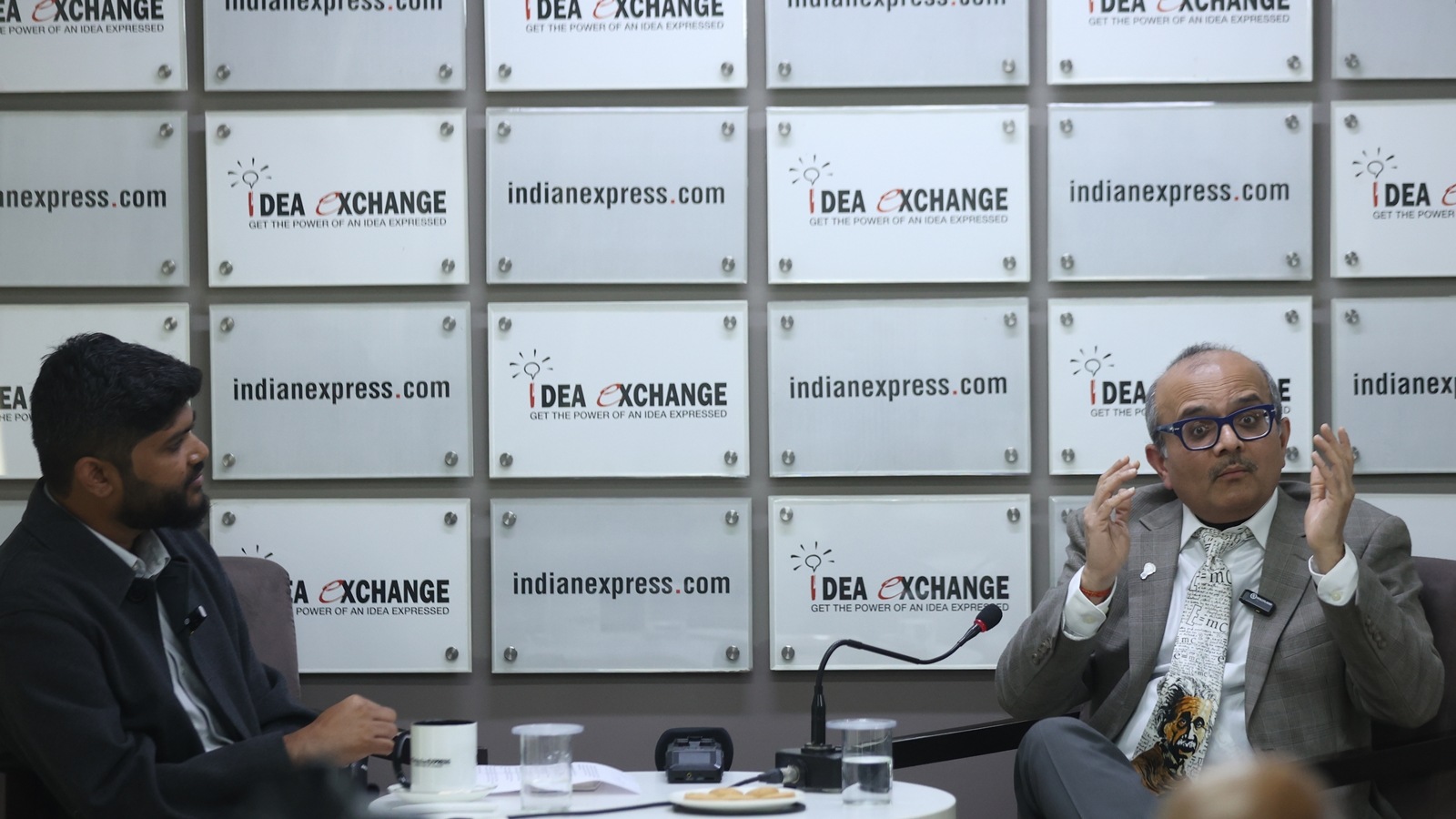
When I came, all the mandates that AIM had for its first phase (AIM 1.0), were met. We were to make 10,000 Atal tinkering labs in schools for children from Class six to 12. We were to make 101 Atal incubation centres — business incubators which take an idea to a startup and provide services. We were to make 50 community innovation centres. And then we were to run Atal ‘New India challenges’ for 200 ministries. The first three got done. In the ‘New India challenge’, we still have a balance of 50 or so. But by and large, the targets were met. In terms of the appetite, there are 10,000 Atal tinkering labs across 722 districts. About 66 per cent of them are rural. And about 95 per cent are in schools. There’s a lot of hunger.
What it took to get here is quite simple — maker spaces, a 3D printer, vinyl cutter, mechanical tools, electronic tools and entrepreneurship tools. There’s a lot of excitement. This is also, interestingly, the only space in India’s schools where there’s no exam, where a student can explore, look around a problem and work on a solution which is exactly the opposite from the rest of the education ecosystem, where a teacher teaches you a solution. Obviously, in real life the problems come before solutions. We had an independent assessment of the first 1,000 labs which are the most mature. The number of innovations, on an average, from a rural school is higher as compared to that in an urban school. Sixty per cent of these are in government schools.
 Chintan Vaishnav, former Mission Director, Atal Innovation Mission (right) in conversation. (Express photo by Tashi Tobgyal)
Chintan Vaishnav, former Mission Director, Atal Innovation Mission (right) in conversation. (Express photo by Tashi Tobgyal)
The greatest challenge for innovation and entrepreneurship to soar in our nation are cultural. Families want their children to be safe and not take risks. For an academic to trust a business person is a challenge. For a business person to believe that an academic can also be interested in practical problems is a challenge. For the government to think that the private sector can as efficiently deliver on some of the tasks is a challenge. For the private sector to think that the government can also be progressive and fast-moving is a challenge. These cultural chasms are the biggest challenge. It is a mindset thing. It has nothing to do with our capability.

Soumyarendra Barik: Could you cite some examples where the region, socio-economic background, literacy level of parents has not mattered and their experience in the societal system has shaped their problem-solving abilities?
The discovery of problems is the most fascinating part for me. For instance, Sivakasi is known for manufacturing fireworks. We have an Atal Tinkering Lab there. These are children of parents who are labourers in these factories. For these children sometimes the factory is their home. The greatest hazard in this process of making firecrackers is when you have to mix chemicals. And if your proportions and processes are not right, there can be an explosion and then it can really burn down a bunch of huts. We all have seen cement mixers on highways which continuously rotate a drum on a truck.
Story continues below this ad
They have taken inspiration from that and tried a mechanical drum to work with these chemicals to make that particular step safer. The fascinating part is that later, we built an Atal Community Innovation Centre in Kalasalingam, which also has a university, which is near Sivakasi. One of the things that happens at these centres is that they do these events. So people from around can come and know what is happening and exhibit what’s happening.

These kids came and they put up their project. Kalasalingam faculty walked by and a chemical engineering person, a physics person, and one from mechanical engineering said that this was quite interesting because now you can even model this. You can say that these are chemicals to be mixed. These are their properties. These are their time constants, catalytic energy.

This is how it should be mixed. This is the angle and the velocity of rotation, angular momentum of the drum. The life of this family is now a mathematical problem. Kids absolutely love it because now they see why they have to learn physics and why they have to learn engineering. If we can give such experiences to children, then we don’t have to tell them to study this or that. They will do it.
Soumyarendra Barik: While we have a vibrant startup ecosystem, our key competitors, the US and China, are much ahead in terms of creating original work. Even our big businesses spend very little on R&D. Will that not hinder innovation and prevent us from being competitive?
Story continues below this ad
It is true, it is a problem. We’ll have to come at it from multiple angles. My theory of change is that hopefully there will be a tipping point beyond which there will be enough examples that more would want to do it. But, at the moment, the scenario is very conservative. For instance, when I came to AIM, I would meet large corporations and ask them, ‘when do you increase your R&D spending?’ Or alternatively, ‘when do you work with a startup that has done the research that you would have wanted to do?’
Their answer would boil down to: if we see a clear connection to our top line or we see a clear connection to the bottom line. And I want either my top line to improve or my bottom line to improve. In other words, I want my portion of the pie to be expanded. But then there are sectors after sectors, with AI, where the pie is disappearing. Then what do you do? The disappearing pie conversation is not happening. That’s what we need.
 Chintan Vaishnav, former Mission Director, Atal Innovation Mission (right) in conversation. (Express photo by Tashi Tobgyal)
Chintan Vaishnav, former Mission Director, Atal Innovation Mission (right) in conversation. (Express photo by Tashi Tobgyal)
Ravi Dutt Mishra: A heated debate on H1B visa is on and it is a part of a bigger problem. Since the politics of the US and Europe is changing, what should we be doing differently?
The picture is as hazy for me as it is to everybody else. I don’t think there is a lot of strategising to be done. It’s just the basic value proposition that we are useful to each other or not and in what ways. The United States ecosystem understands which startups to leverage. Zoho, for instance, has gone across the world.
Story continues below this ad
Anil Sasi: There is still a considerable gap between risk takers and risk funding in startups. A lot of the initial funding still comes in from family. To what extent do you see this gap narrowing and how crucial is funding beyond the non-traditional means?
As to reducing the gap in the future, there are fairly large swaths of our economy that we have not yet tapped into. So a very large fraction of India’s GDP is vernacular businesses. These are not businesses that are in the startup land at all. They understand business very well. They don’t consider startups as an asset class. By one measure, 60 per cent of India’s GDP is in vernacular businesses. We’ll have to engage with them; with small amounts of risk.
On urban vs Rural innovation | We had an independent assessment of the first 1,000 labs which are the most mature. The number of innovations, on an average, from a rural school is higher as compared to that in an urban school
If you want to put a lot of money, that’s a late- stage game. But if you want to put some money in, it’s an early-stage game. The government has given a lot of early stage grant money. Our experience with that has been that the return is pretty handsome. This is government money, so it is not really saying that only if you give me my return will I invest in your risky idea. This is more risk-loving capital. The one challenge is that the quality of ideas is still is variable.
Anil Sasi: How important is it for startups to benchmark themselves to what’s happening in developed markets? Also, in this new AI space, which is still uncertain about monetisation, do you see Indian firms having an opportunity?
Story continues below this ad
This sort of theory about thinking global from the get-go is now at least known to people. So they will strive in that direction. In certain sectors which are leading, say FinTech, e-commerce, there’s also know-how. But that knowledge is still in limited spheres and not widely available. As it does become more available, there’ll be more of it. At the same time, there could be an over-fascination with unicorns and global ideas. In some sense, you can have a very healthy market in our country and that would be fine. But in neither cases can you really compromise the fundamentals of business.
 Chintan Vaishnav, former Mission Director, Atal Innovation Mission (right) in conversation with Soumyarendra Barik, Special Correspondent, The Indian Express. (Express photo by Tashi Tobgyal)
Chintan Vaishnav, former Mission Director, Atal Innovation Mission (right) in conversation with Soumyarendra Barik, Special Correspondent, The Indian Express. (Express photo by Tashi Tobgyal)
Harish Damodaran: Why is it that most of our innovations are coming in services? Why are we not able to bring this innovation into manufacturing?
For young people doing startups, and for investors too, doing a startup in services, SaaS (Software as a Service) and e-commerce, it is a practical choice. Most of our young entrepreneurs do not have deep pockets. They are choosing something with a fast clock speed to build a software, where the return is in three years, say best case, five years, worst case, 10 years.
There is nothing wrong with it. That trend will go on and we should keep an eye on the other trend, but we should never expect our people to be more impractical because this person is already taking risks against their family’s wishes. We have to embrace them. When somebody sells their first startup and has a little deeper pocket, then they will do something in bio manufacturing among others. There are many examples of this. Capability is there, but weaving it together, taking it together, it takes its years of work.
Story continues below this ad
Soumyarendra Barik: We are now exploring cutting-edge sectors like semiconductors. The change and money is being driven by the bigger firms but the suppliers are often from China or Taiwan. We are going towards Taiwan plus one or China plus one in smartphones. How can that change?
So China plus one or Taiwan plus one is not our achievement? It just happens to be there? How will we get into this sphere of vision and have a bigger picture and a strategy to make, to become globally competitive? I think that will have to start in education. Why is it not happening or scaling across the world? Because it takes teachers to do a lot more work. Maybe AI will help. We will have to teach. The children will then create something new because they have those skills and a perspective.
Raj Kamal Jha: If Kota and JEE remain the gateways, how do you link Atal Labs to this? Do IITs have a role to play in outreach to schools?
It’s experimentation all along. Some of the IITs, BITS Pilani among others, have begun to reserve two seats for somebody coming on the basis of innovation. That’s a great start. The tension of the JEEs versus tinkering is going to remain, because again, an average parent wants a secure path, a prestigious path. They don’t link this to science and mathematics at all. One of the things that we are trying to do is to bring parents into the fold and invite them into these exhibits.
Story continues below this ad
But, on a very small scale, the Atal Tinkering Labs with 10,000 labs are still only in five per cent of our schools. So we’re not transforming the country. But you step back and look at what is happening to our human capital. For every 100 that enter school, 28 go to college, 72 don’t.
What about those 72? The present battle is to open Atal Tinkering Labs to everybody and not only somebody who is good at mathematics and physics. We have the potential to do a lot . There are a lot of people who can do so much. We still don’t have a pathway. All of those institutions will have to change. And this new pathway will have to be there. JEEs will do JEEs. We need scientists. Nothing wrong with it.
Yashee: We talk of involving parents, but is there an element of involving teachers in these tinkering labs? In schools, teachers are not really thinking about innovation. They have a syllabus to complete.
Teachers are, of course, the linchpin. In Jammu Kashmir, we said that we will not restrict tinkering lab training to only those schools that have tinkering lab, nor to only those teachers who are in charge. We said we will get into the state departments training programme, and we will train everybody, all teachers. The results are phenomenal. Last year, in the Atal Tinkering marathon, where there were 20,000 teams. The national average was 3.2 per cent. Jammu Kashmir was 36 per cent.
Story continues below this ad
Soumyarendra Barik: In your four years working closely with the government, do you see a scopefor innovation?
In science, technology and innovation, the policy processes, which are largely consensus based, have the danger of diluting the outcome. Because you’re trying to cater to a diversity of opinions and in science, we have to be bold enough to follow that one right way. We have to drive towards people who have spent a long time with some of these subjects, like quantum and semiconductors, sophisticated subjects that a person working their entire life is still struggling to understand.
The second thing is that something is fundamentally changing. AI, as its influence grows, is for the first time putting us in a paradigm after the industrial revolution, where the clock speed of technological change is faster than the clock speed of institutional decision making. This is not a paradigm we have had. Even with the fastest growing technologies like say mobile phones, it took 20 years before it reached saturation.
On lack of innovation in manufacturing | Most of our young entrepreneurs do not have deep pockets. They are choosing something with a fast clock speed and faster returns. It is a practical choice and there is nothing wrong with it
So we had time to catch up. We won’t have that time. We are in a non-deterministic paradigm. You have an input and a predictable output. Here, the thing in between is learning. So, you may not have a predictable output. As a result, decision-makers who are very well-meaning simply don’t have the tools to grapple with this.
Raj Kamal Jha: Then you also have lakhs of young men and women, out of school or college, preparing for a few thousand government jobs. How do you see your roadmap for innovation making a difference to this? Have we lost a generation?
Yes. And I don’t know how long it will take. I feel that the innovation ecosystem work will take 40 years. It has taken that much time for other nations. There’s more technology and globalisation, so it may shorten it a little bit. But building those institutions will take time. And we are disruptors. The incumbent is the exam only. And in the classic Christiansonian sense, the incumbent is going to ignore all of this until this trend gets to a point where somebody from this trend can marry easily, and can have a better retired life.



 Chintan Vaishnav, former Mission Director, Atal Innovation Mission (right) in conversation. (Express photo by Tashi Tobgyal)
Chintan Vaishnav, former Mission Director, Atal Innovation Mission (right) in conversation. (Express photo by Tashi Tobgyal)


 Chintan Vaishnav, former Mission Director, Atal Innovation Mission (right) in conversation. (Express photo by Tashi Tobgyal)
Chintan Vaishnav, former Mission Director, Atal Innovation Mission (right) in conversation. (Express photo by Tashi Tobgyal) Chintan Vaishnav, former Mission Director, Atal Innovation Mission (right) in conversation with Soumyarendra Barik, Special Correspondent, The
Chintan Vaishnav, former Mission Director, Atal Innovation Mission (right) in conversation with Soumyarendra Barik, Special Correspondent, The 





























